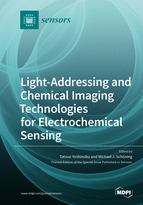Light-Addressing and Chemical Imaging Technologies for Electrochemical Sensing
A special issue of Sensors (ISSN 1424-8220). This special issue belongs to the section "Chemical Sensors".
Deadline for manuscript submissions: closed (31 March 2020) | Viewed by 26844
Special Issue Editors
Interests: chemical sensors; chemical imaging sensor; light-addressable potentiometric sensor
Interests: silicon-based chemical sensors and biosensors; field-effect devices; thin film and semiconductor techniques; micro- and nanosystem technology
Special Issues, Collections and Topics in MDPI journals
Special Issue Information
Dear Colleagues,
Spatially resolved measurement or “visualization” of chemical species in a specimen is an essential technology for analysis of electrochemical systems and biological samples. As a complementary technology to optical methods and scanning probe technologies, solid-state sensors for visualization of pH, ions, molecules and even living cells and microorganisms have been developed in analogy to image sensors for visualization of light.
This special issue aims to compile the state-of-the-art technologies of solid-state sensors for chemical imaging such as light-addressable potentiometric sensors (LAPS), scanning photo-induced impedance microscopy (SPIM), ISFET arrays and CMOS sensor arrays etc. and related light-addressing technologies for spatially resolved control of electrochemical reactions. Both latest research trends and applications of chemical imaging technologies are addressed in this issue. Topics may include the following:
- LAPS / SPIM technology, instrumentation and materials
- Chemical imaging by LAPS, SPIM, ISFET array and CMOS sensor array
- Applications of chemical imaging
- Light-addressable electrodes
- Light-activated electrochemistry
Prof. Dr. Tatsuo Yoshinobu
Prof. Dr. Michael J. Schöning
Guest Editors
Manuscript Submission Information
Manuscripts should be submitted online at www.mdpi.com by registering and logging in to this website. Once you are registered, click here to go to the submission form. Manuscripts can be submitted until the deadline. All submissions that pass pre-check are peer-reviewed. Accepted papers will be published continuously in the journal (as soon as accepted) and will be listed together on the special issue website. Research articles, review articles as well as short communications are invited. For planned papers, a title and short abstract (about 100 words) can be sent to the Editorial Office for announcement on this website.
Submitted manuscripts should not have been published previously, nor be under consideration for publication elsewhere (except conference proceedings papers). All manuscripts are thoroughly refereed through a single-blind peer-review process. A guide for authors and other relevant information for submission of manuscripts is available on the Instructions for Authors page. Sensors is an international peer-reviewed open access semimonthly journal published by MDPI.
Please visit the Instructions for Authors page before submitting a manuscript. The Article Processing Charge (APC) for publication in this open access journal is 2600 CHF (Swiss Francs). Submitted papers should be well formatted and use good English. Authors may use MDPI's English editing service prior to publication or during author revisions.








